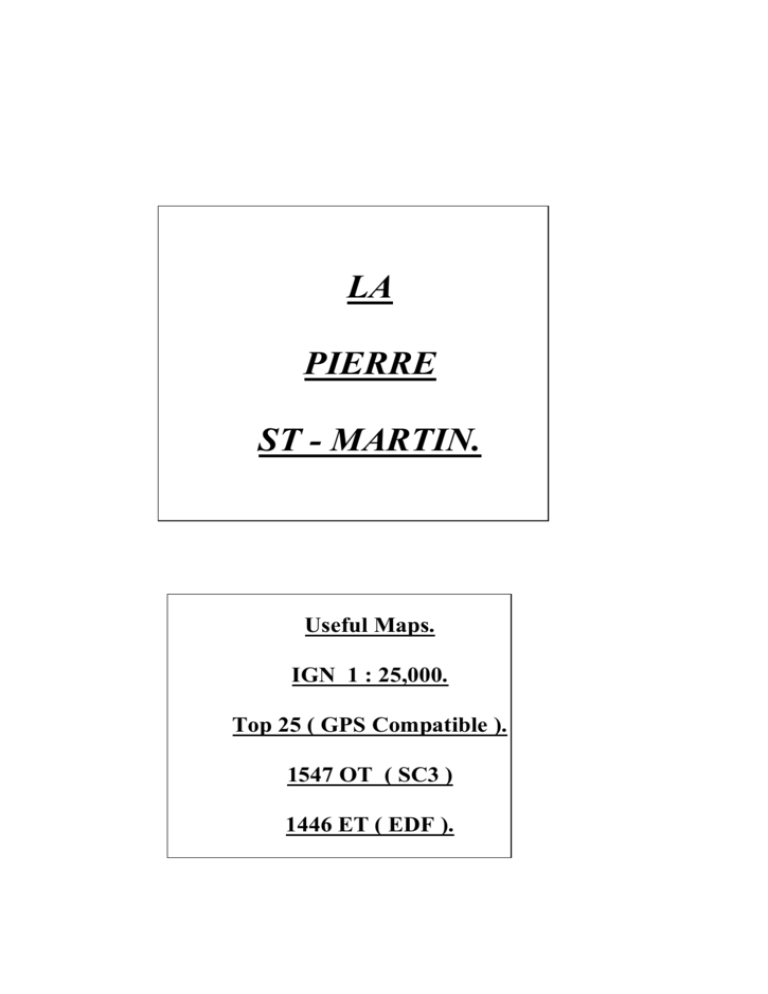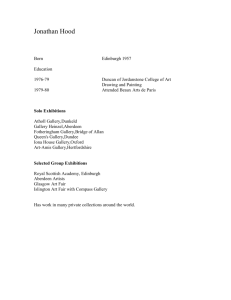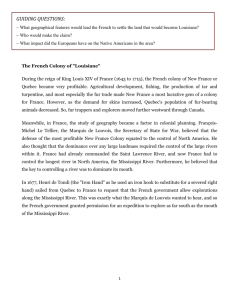here
advertisement

LA PIERRE ST - MARTIN. Useful Maps. IGN 1 : 25,000. Top 25 ( GPS Compatible ). 1547 OT ( SC3 ) 1446 ET ( EDF ). Traverse Beffroi ( SC3 ) to EDF Tunnel. X 349.878 Y 78.205 Z 2037m Depth - 983 to EDF, -1057 to base of la Verna. Time 14 - 18 hours. 430 m of rope. SC3 to Galerie Bassaburuko. Splendid pitches - little in of interest in chambers below. Stay on the rope to -95m ( P’s 16m, 26m, 6m, 6m, 45m) . Unstable boulders at -40m, they fall onto the 45m pitch. At - 95m , boulder passage cut by to drops of 5m. Cross over p2 in a rift to reach 60m pitch. Narrow for the first 25m and then it breaks out into a vast fault for 20m. Peddulam to get to other side of bridge. Way on is a little more complex. Traverse around a pitch in a fissure to reach the top of a narrow meandering staircase. Descend for 30m to where it widens. 10m on is the start of the puits Beffroi (91m). this can be rigged as pitches of 23m, 15m, 8m, 12m, 18m, 10m and 5m ( also could be rigged to make longer drops ). Puits Beffroi ends at -285 in a small pool . A comfortable meander continues to Liberty Bell, a 54m pitch vast and free hanging. From the bottom of the pitches a few Metres of tight fissure to blocks. After a further 30m at -335 is Galerie Bassaburuko. 1 hour if rigged, 3 to 4 hours if not. Galerie Bassaburuko to Salle Cosyns. The extreme top of Bassaburuko is quite complex for the fist 100m , but it is difficult to get totally lost. Fissure from SC3 leads to a good sloping passage. Do not go upwards ( 1 km labyrinth ) . Look for a gallery 2m high in the opposite wall. 100m on the first river enters on the Left. 20m on, two routs down are possible, the upper in a fissure , the lower wet way. The wet way is a slightly smaller passage but it is very easy. 20m on take a tube oxbow to the right which leads back to the stream after 50m. 20m on the river Bassaburuko enters on the right. 150m further and the two ways re-unite to form a fine active streamway. Follow this for 600m to the salle ARSIP. It is complex here and there. Either follow the river or take the fossil passage up on the Left. There are several fossil passages here. Advisable not to take the wet laminoirs as they are long and unpleasant. At the end of this section there is a cascade of 4m, easy in normal conditions but dodgy when wet in which case the Tunnel du Vent will be sumped anyway. Salle ARSIP is 50m by 20m by 15m. At the base is boulders to the river and deep pools. These are avoided by taking a small climb to a gallery rising steeply to the right and dropping to the left. 100m on you regain the stream beyond the pools, further ahead there is another pool , but with a hand line in place. There is no difficulty from here. Follow the stream and where it sinks to the left follow the fossil passage. 80m on the stream enters the fossil passage and an easy 5m pitch drops into the Salle Cosyns at -539m from SC3. 2 or 3 ropes of 15 to 20m can be useful for sorting out any problems between the upper and the lower passages. Salle Cosyns to Grand Canyon. ( length 900m ). Follow through Salle Cosyns until you pass a large block. Behind the large block is 20m of fossil gallery which drops into a deep pool. Here an easy climb of 4 to 5 metres leads to a fossil gallery which bypasses the pool. the water beyond is easily crossed to reach a short rising gallery which ends at a 7m climb upwards. Above another gallery leads for 30m with a 6m climb and a traverse to a 8m climb and regain the river. Follow the river for 150m to where the roof lowers. Take the window on the left which leads into Salle Pierrette which contains another river ( Max Coudere ). Cross the gallery and face the window and you will see a small chaotic gallery which ends after 50m at a pitch upward. The way on is through boulders to the right 15m before the pitch. After a low passage regain the river and follow it for 150m, avoiding pools by traversing and a fossil tube on the right. This leads to the Salle Manqué ( 100m X 30m ) which you cross on the left. The end of the Salle is scarred by old camp sites. At the end of the Salle a 6m climb in a fissure leads directly onto a lake of 20 diameter which is crossed on the left , the right being deep. Soon after this is the vast Salle Susse 280m long by 50m wide. Cairns and scotch tape mark the rout through. ( M31 traverse comes in through boulders in the middle of the chamber ). To the right of the chamber is a high arete of boulders. Then soon starts the steep descent to the left. A few climbs and boulder climbs and you reach the active stream again. This is the start of the Grand Canyon. Grand Canyon to Tunnel du Vent ( length 2.6 KM ). This is the best part of the traverse. Easy in dry weather but daunting when wet. It starts large ( 1m to 10 m wide and very high ) and the river is nearly always with you. Immersions are frequent, but the deep pools are avoidable except the Tunnel du Vent. Grand Canyon. The first part is rapids with mud and gravel banks, avoid the deep pools. There are four boulder barriers where the way on is half way up and obvious. The last two are the most important. A short distance after the fourth boulder barrier, 1200m from the Salle Susse the walls narrow and progress is entirely in deep water 0.75 to 1.2m deep, very dangerous in wet weather. The river can be very fast flowing . the end of this section is marked by a widening of the gallery and more mud and sand banks. Soon the walls close in again and the roof lowers. An upper gallery is easily reached by a 6m climb and leads to the Galerie des Marmites. Galerie des Marmites to Grand Corniche. This is a fossil gallery with many flooded pots. About half way along the gallery there is a delicate 5m climb up, bypassed by a climb on the left to a small affluent. The 5m climb is usually equipped with abandoned ropes !! Check it first. Towards the end of Galerie des Marmites a small outflow runs for 20m and ends at a 2m climb. Here the character of the cave changes dramatically and you enter a rising gallery of boulders. After 20m it rises to the right to a 4m climb and a larger part of the gallery. ( This can be bypassed by a long wet passage needing a dinghy ). Ahead a few large blocks indicate the old camp of Grand Corniche. ( A lot of rubbish ). The Corniche is 8m long, 0.8m wide and runs for 20m along the roof of the gallery. Just beyond is an easy 7 or 8m climb down. Le Shunt d’ Hiidalga to la galerie Principe de Viana. Going downstream the gallery is still fossil, very high and 2 - 4m wide and noticeably higher by several metres on the left. 100m from the Grand Cornich boulders in the middle of the gallery indicate a change in progress. Climb up the left wall for 5m to a large part of the gallery, from here still on the left a series or lateral tubes rise to the top of the Puits Hidalga (25m). An easy rising rift to the right at the end of the tube ( the shunt ) takes you to the large passage above the pitch. This is the start of the galerie Principe de Viana. Drop down boulders to a very low descending passage to the left to regain the main river of the P.S.M. Progression is through a series of pools up to 50m long. Follow the right wall ( you will be out of your depth for a few Metres ). The end of the gallery is marked by a climb up boulders into a chamber. Drop down the far side to the first pool of the Tunnel du Vent. It is short with a low roof. A few metres beyond is a rise to the right in a small decorated passage to the second pool and the junction with the affluent d’ Arlas. the second pool is 50m long and needs a boat. It has a low roof and a very strong draught, it also sumps easily. The Tunnel du Vent leads to the start of the Grand Salle de Pierre. Tunnel du Vent to la Verna ( length 3.6 KM ). The most difficult part for rout finding is from the Tunnel du Vent to Salle Lepineux. Numerous pieces of equipment and markers could lead you astray for hours amongst the boulders. In 1985 ARSIP cleared all the rubbish and laid new markers. From the Tunnel du Vent follow the right hand wall ( the markers now show the way ). After some passages and traversing some blocks, you reach large boulders rising to the right. 20m up slope turn sharply to the left and look for a passage through the boulders, which should take you into Salle Navarre ( which is 220m long and 50m wide ). A steep decent follows for the next 20m along the left hand wall. after a further 150m you reach the lowest point of the chamber 10m from the left hand wall. 50m further along the left hand wall is another very complex area of chaotic boulders. Enter the blocks to the right do not lose the markers, you will eventually reach a fixed ladder up 10m up. The gallery beyond is 30m wide and 100m on is Puits Lepineux at the top of the Salle Lepineux. Steep rapid decent in a conduit and on boulders. Veer left along an enormous block. This is where the plaque in memory of M. Loubens is to be found. A little bit further and the chamber finishes in another chaos of boulders above Salle E. Casteret. Access is via a 10m climb. In this chamber descend the boulders along the left wall for 50m. then cross over to the right at the same level. 100m further is a rapid decent to the lowest point of the chamber. Climb up to the right hand wall where, 50m above there is a passage and a balcony which leads abruptly to the Salle Loubens. The markers end here. Cross the Salle Loubens to the left. At the bottom are fine gour pools and the first water since the Tunnel du Vent. Beyond is the vast Metro. The Metro is 600m long with a flat roof for 150m. There is a footpath along the left hand wall. Progress is easy and dominated by the river. The end of the Metro is marked by a high barrier of blocks. Stick to the left hand wall. enter hole through which you can see a wall of a chamber above. The hole has a dodgy fixed ladder of 10m, but the climb up is easy. You arrive at Salle Queffelec. Follow for 200m along the left hand wall. At the lower end avoid entering the descending gallery but, still keeping to the left follow the balcony with a chaotic gallery above. After 50m the gallery swings left. Look straight ahead and enter a low passage in boulders ( 2m high ) which leads to the Salle Adelie. Continue to follow the left hand wall. you will end up 30m above the floor along which the river flows. 50m on the passage becomes a traverse ( rope ) to a small col which cuts the chamber in half. A rapid descent is made to the river here still on the left. The active gallery here is 10m by 15m. Descend on left and enter after 100m a small fossil gallery on the left. The draught is strong and quickly arrive at a pool with a low roof and 1m above the water there is a ledge for a dry crossing. 10m further on is the Salle Chevalier, it is 380m long and starts with boulder dam. The passage shape is a ‘V’ in cross section. Descend the passage on the left for 120m and then cross the river and look for a spacious traverse on the right. From here there is an easy footpath down to the end of the chamber. Below the footpath is boulders to the river. a balcony on the right avoids a cascade. The Verna is less than 200m from here. Follow river or take passage through blocks on the right as they both unite at the top of the Verna. Salle de la Verna to The Tunnel du Vent. Length 3.6 KM height gain 350m. Two ropes of 20m are handy, Some of the fixed aids may not be there. Wear warm cloths. Entrance to Metro. Follow the EDF tunnel for 700m turning right after 400m. After some boulder passage the Salle de la Verna is reached. It is 250m in diameter and the main PSM stream sinks 70m below the entrance of the chamber. After a series of cascades 80m high turn left and follow a path on a ledge up to the top of the chamber and the river, here two routs are possible. Follow the water if possible otherwise take the all weather rout to the left between blocks. The two routs reunite in a large chamber further on. 150m from the Verna are some large pools. Avoid them by a ledge on the left. Stay with the left hand wall and climb a boulder slope to the foot of an easy climb of 7m. At the top you will find the start of the Salle Chevalier which is 380m long and 60m wide. Following up the chamber is easy, The easiest rout is from the end of the characteristic ‘v’ cross-section. first on the left of the river and then on the right. It is useless to try and climb the walls. Towards the end of the chamber the roof lowers and the river is regained. You reach a canal passage. There is a balcony on the right which just avoids the water and leads to a small fossil gallery, followed by a larger one where the river flows. Follow the gallery up on the right hand side and into the Salle Adelie which is 150m long and 50m wide. For the next 1000m follow the right hand wall. The Salle Adelie is cut in two by a large boulder pile climb up it 50m along the wall to a little pass and stay at this level. In the second part of the chamber to look for a higher gallery. This is obscure. It turns to the right. Do not follow it down, but cross over and enter its upstream section. This quickly leads to a boulder balcony overlooking the Salle Queffelec. Below you can make out the vast gallery of the Metro. It reached by a shaft of 8m between blocks along the right hand wall. It is often rigged but mat not be. Metro to Lepineux Shaft. Below the 8m shaft a boulder slope descends toward the river last seen at the beginning of the Salle Adelie. The Metro is 600m long 30m wide and 40m high. For the first 450m you overlook the river. After another boulder chaos the gallery levels out and the river disappears to the left. It is not seen again until the Tunnel du Vent. 150m on is the Salle Louberns. There are some straws in the roof and some magnificent, but damaged gours. Climb the gours to the right and stay close to the centre of the chamber. The slope lessens and the way on passes under a boulder arch to lead to the smaller upper part of the chamber. 50m past the arch and climb back up the boulder slope to the left as far as a balcony which over looks the river to the right. The markers placed by ARSIP, and leading to the Tunnel du Vent start here. Continue to climb up to the left to a high point. This is the entrance to the Salle E Castet. Descend for 30m to the bottom of the chamber and climb the earthy boulder slope opposite. This is quite steep and leads half way up the chamber. As soon as the slope lessens cut across obliquely to the right to get closer to the wall. Another steep slope is reached and a well marked path leads to a huge chaos of boulders (Gibraltar ) and into the Salle Lepineux. Gibraltar is passed by climbing a 10m pitch in the boulders and a rope is useful and the climb is loose. The climb is followed by more boulders, but 20m on several passages lead down to the bottom of the Salle Lepineux. The first passage follows the right hand wall past the 50’s campsite and some words written by N Casteret in memory of M. Loubens. This leads to the base of a steep rockfall. Climb up to the left towards the top of the chamber. At the top the Lepineux shaft comes out through the ceiling. Lepineux to the Tunnel du Vent. From here gently descending vast gallery 30m wide should be followed on the left. after 100m turn obliquely to the left and look for the top of a 10m pitch / climb where a rope is useful. This is the start of the Salle de Navarre and the most complex part of the rout. Follow the markers through the blocks to the right hand wall and then to a beach of large pebbles followed by an other climb up a boulder slope for 120m. The way on seems to be blocked by boulders, but it is possible to pass it by staying fairly close to the wall. Beyond is a large gallery which drops to the right. Cross it to get to the opposite wall and follow this all the way to the Tunnel du Vent. It soon bends to the left. The gallery to the right is a boulder choke. Ahead you soon regain the river last seen at the Metro. 50m on the roof lowers and the river issues from a low tunnel with a strong draught. This is the Tunnel du Vent. From La Verna to the bottom. Length 1.6km depth 341m from Verna tunnel. 360m of rope needed. La Verna to La Galerie Aranzadi. From the end of the EDF tunnel, take the path to the left of the platform and go down the pebble beach. At the end of the chamber ( minus 71m ) climb down the other side following the wall southwards for about 60m. The start of the path to the gallery is easy to find with its traces of flat rock and above all a channel in the wall where a trickle of water flows. This is a torrent in wet conditions. Climb this channel for 25m and veer slightly to the left to find an easy 6-7m climb up. Move right, back to the channel, climb up 10m and move left under a block to the start of a steep unstable boulder slope for 20m. This leads to a clay wall where steps are cut. move 8m to the right into a high window. The Aranzadi Gallery is easy and 300m long. The Martine Meander starts on the right 40m from the end. Martine Meander. The first part of the meander is 180 long and contains some short narrows and some easy climbs with the exception of a 6m pitch into a shallow basin. A stream flows in the meander and it leads to the Salle Mus. This is 15m by 8m and marks a change in direction of the cave from North to due West. Cross the chamber and look in the opposite wall for an obscure high window several metres up. Through the window a sort descending gallery runs into a high narrow fracture, the Ravierm fault. this runs for 380m to the Salle Trottier. Progress is made by mid height traversing. After 100m traverse over the Barres shaft ( rope useful ). 70m on is the end of the fracture and a 17m pitch ( 6 and 16 ) into 20m of narrowing passage. Beyond is an other mid height traverse in a continuation of the original fracture for 190m. This leads to a large fossil gallery and a short descent into a stream which receives a tributary on the left. Soon after this the fracture leads into the Salle Trottier which contains a lake. From here a new meander leads over two small cascades into a larger passage only 20m long followed by another meander for 15m to a crossing of faults and the start of the wet shafts. ( Beyond is over 1km of the Oliver - Martin complex ). The Aziza - Parment Shaft. From the meander follow the water down the first shaft of 6m to the Salle de Montpelier ( -120m ) . This is the last dry spot. Lower down it is not always possible to rig the pitches dry. Next shaft is at the end of the chamber under a boulder slope. It is the Aziza Shaft if 45m, dry for 15m then wet. It is possible to rig from the large ledge at -15m. An easy toboggan follows to two cascades of 5m and 6m. The follows a short meander to Joysane Shaft ( 18m ) . Then down a cascade to a pool on a ledge. It is wet below. Immediately below is Dubreuil Shaft of 33m ( 5 and 28 ). Certain shower at the bottom. Followed by another toboggen of 40m with two cascades of 5m and 8m, both requiring complete rigging. Below the cascade of 8m is the next shaft Basson Shaft of 17m immediately followed by the Parment Shaft of 40m Below the system finishes in a tight squeeze at - 341m ( - 1342 from the top entrance ). Equipment. Pitch length. Le Martine Aziza-Parment. 6m 17m Rope length. 10m 25m 20m for crossing Barres Shaft. 20m for Salle de Montpelier. 65m for Aziza. 25m for cascades in first toboggan. 25m for Joysane. 100m for Debreuil and second tobaggan. 85m for Besson and Parment. Take at least 25 hangers, some tape slings and some deviations. The Tete Sauvage - Verna Traverse. X 348.72 Y 78.31 Z 1882m. Length 7.7 km depth 909m. 430m of rope. Tete Sauvage to Salle Cosyns. Fixed hangers as far as -180m . When it rains the cave gets wet , but otherwise it is dry. From the entrance a short meander leads to small pitches and ressauts to -55m. The 40m Puits de la Tortue reaches about half way down the first meander which ends in a squeeze, which pops out suddenly onto a pitch of 46m. At the bottom, the passage enlarges ( -117m ). Two small climbs leads to boulders below which is Damocles 25m. Rs 5m, 2m and 7m lead to -180 and the end of the fixed hangers. The following pitches are 32m and 17m and are difficult in wet weather so rig dry. At -220 is the second Meander which is 30m long and cut by pitches of 10m and 3m. The narrowing after a 2m climb is difficult when wet and leads to the top of a 21m pitch. The third meander is short and large at the top of the 92m pitch at -277. The pitch is really a series of short drops of not more than 25m. At the bottom is a little stream followed shortly by an elbow to the left in a low tube, the Soupirail or wind tunnel. This leads to the fourth meander which is 60m long and ends in a 8m pitch where you can clearly hear the water from Bassaburuko which flows at the bottom of Salle Cosyns. The top of the next pitch which is 8m is dangerous as it is in a band of schist. Also it is very wet. The pitch leads to a balcony half way down the wall of the Salle Cosyns. You can drop directly on to the chamber floor via a 6m pitch or take a fissure down to the river and climb back up the chamber floor towards a large block. The way on is behind the large block ( -384 ). Traverse Gouffre du Pourtet ( M31 ) to Salle Susse. Length 10,950 to Verna. Depth 1004 to EDF 1075 to base of Verna. The wide entrance is usually plugged with snow until mid July. At -16 passage between wall and ice forms a 16m pitch. Half way down swing into a window and this leads to the start of a series of narrow pitches 7m, 3m, 3m and 11m. This leads to Puits de la Lame which is 14m. At the base of the pitch ( -55m ) the size increases at the round 100m Puits Parfait, rigged as pitches of 16m, 12m, 9m, 23m and 15m. At -155m careful passage through tremie onto a 23m pitch to a fissure which leads to the 70m Puits Pathetique, rigged as pitches of 8m, 11m, 19m and 32m. 25m further on is a ledge which you follow to the left. Here, to the left are pitches of 10m and 35m to an impassable squeeze. To the right is a series of R’s 10m, 8m, 5m and 3m to a narrow meander at -260m. This leads to a 25m pitch followed at once by the 74m Puits Hypothetique rigged as pitches of 15m, 18m, 10m, 9m, 8m and 14m. In wet weather this pitch is very wet. At the base of the pitch ( -356m ) climb a fault to reach R’s of 8m and 4m to a 15m pitch. 4m down swing into a fault window on the right, squeeze through and descend a further 3m to the top of a 14m pitch. There are schist bands here. Base is at -381m. Follow the small stream to a 3m climb and the end of the entrance pitches at 394m. You can go from the entrance to -381 without getting off the rope. However the equipment required is in the order of one rope of 40m, three ropes of 200m, one rope of 8m, 78 hangers and 4 deviations. Galerie des Sables to Salle de la Tremie. Length 1.2km from the 3m climb at the end of the entrance pitches thread your way through boulders where the water filters. After the tight passages turn right and go uphill. 15m further you reach a passage after a sharp right hand bend. Go up this gallery for 200m to another sharp right hand bend. In the elbow is a tight gallery, you will find a stream entering from the right wall and sinking quickly into a low tube. Follow the fossil passage which is floored with sand and contains formations until you come to Gallerie d’ Octobre. Turn left and follow this gallery down to a pool which needs a 10m rope on the left. Beyond is another pool which needs a boat ( after the river has reappeared from the left ). From here wet rout leads to Galerie des Six, fossil and very full of formations. 50m after another elbow to the right you arrive at the Salle de la Tremie which very nearly marks the end of M31. Salle de la Tremie to Rio Larumbe. Length 1.5km. Cross the chamber and search for a passage in the boulders against the wall, follow the draught. A series of squeezes regains the river in a bedding 40cm high and 120m long. Watch out for flooding. After this the streamway is as far as Salle des Deux Porches. This is the start of the best of the river Pourtet. The Gallery des Cascades. No ropes and progress is superb. This leads to Laminior des Aiguilles which you pass via an upper fossil section. Turn left to leave the river, you regain the river after a descent of 50m and follow the stream in a high, narrow passage. The stream suddenly sinks under the left bank. A few metres further on another elbow leads to a decorated passage with a low roof and a sandy floor. 300m after the chamber, climbs of a few metres in blocks leads to the grand Salle du Rio Larumbe. Le Larumbe to Salle Susse. Length 750m. No more boats needed. No more deep water until the basins in the Grand Canyon. Progress along the Larumbe is easy. 650 of large chambers and galleries with a few shallow pools towards the end. Then follow an elbow into a new chamber. A stream enters on the right, this point is below the Salle Susse. To get there requires a climb up through boulders for about 50m. The route is marked. You can reach the Grand Canyon through boulders at low level it is wet and nasty.









